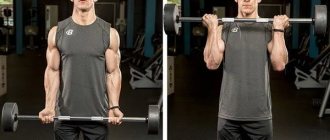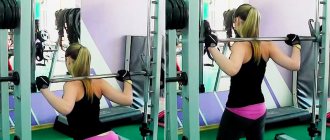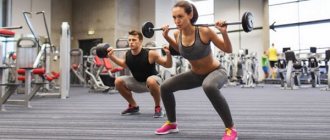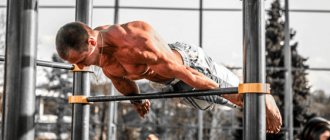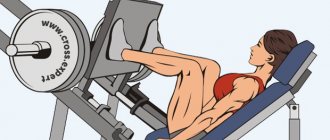The bench press is one of the most popular exercises. To complete it, sometimes you have to wait: a rack with a horizontal bench is almost always occupied. There is no need to waste time waiting: the equipment for the incline version of bench press training is often empty, especially since horizontal bench press alone is not enough to improve physical fitness.
- Incline Barbell Press: Distinctive Features
- What muscles are involved in the work?
- Benefits of Exercise
- How to choose a bench angle
- Technique for performing incline bench press
- Incline Bench Press
- Video: Nuances of the bent-over barbell press
- Bench press on an incline bench upside down
- Video: Technique for working with a barbell in a downward bend
- Smith Machine Angle Bench Press
- Video: Smith machine training
- Narrow or wide: different types of grips when working on an incline bench
- Incline bench press for girls
- Video: Example of a women's training program including the incline bench press
- Practical tips for performing the exercise
Incline Barbell Press: Distinctive Features
The bench press exercise with a barbell, performed at an incline, is basic because it involves several joints and muscle groups at the same time. It is a variation of the classic training using a horizontal bench. Changing the starting position results in a different load distribution, allowing, depending on the selected inclination, to work out the target area in more detail.
Competitive athletes usually perceive this press as an auxiliary element of training, since it involves working with lighter weights compared to the classic version. However, in amateur sports, the main goal of training is not to lift the maximum possible weight, but to perform high-quality muscle development and generally improve physical fitness. The incline press does a great job of achieving these goals.
What muscles are involved in the work?
The main load in this exercise is borne by the pectoralis major muscle, which anatomically has two heads:
- clavicular, located on the front side of the collarbone;
- sternocostal, covering the lateral region of the sternum and the 6 upper ribs.
Conventionally, this muscle mass is divided into three sections - upper, middle and lower. By changing the angle of the bench, you can shift the load, activating a particular area more strongly in accordance with your training goals.
The following muscles are involved in movement as auxiliary muscles:
- triceps;
- anterior deltoid bundle;
- pectoralis minor muscle;
- serratus anterior muscle.
m
Benefits of Exercise
Experienced athletes agree that the overhead incline press puts more strain on the pectoral muscles compared to training on a flat bench. This is due to the fact that in the “classic” a significant part of the load is taken by a stronger area - the lower chest. In addition, the triceps are actively involved in the movement. With an upward angle, these muscle masses are activated less and the movement is performed primarily in the middle and upper chest. This allows you to better work out muscle groups that are, as a rule, lagging behind.
With
The incline press has more variety than the horizontal press. By changing the starting position, the athlete can shift the emphasis of the load to different areas of the chest, triceps or deltoids, depending on the goals of the exercise.
This version of the pressing movement allows you to effectively use a larger number of muscle groups while working with lighter weights.
Features of the exercise
The machine chest press, unlike the bench press, is considered an isolation exercise. Leaning your back on the bench, you push two independent handles in front of you. The amplitude of movement of these handles is clearly defined. Because of this feature of the simulator, movement occurs only in the elbow joint. As for the distribution of the load, it is concentrated as much as possible on the chest muscles. The stabilizer muscles, which are actively involved in the work when performing bench presses with free weights, are practically not involved in this case.
Chest press in a sitting machine in an inclined position.
The chest press on the lever machine is used to finish off the pecs after performing basic exercises.
Benefits of bench press:
- Accented load on the pectoral muscles, minimizing the work of the stabilizer muscles.
- The ability to work separately on the right and left sides of the chest, thanks to the independence of the handles of the simulator from each other. This can be useful if there is some muscle asymmetry.
- Safety of the exercise in terms of the likelihood of injury. As long as you follow the technique and avoid exorbitant weights (which in principle are not used in this exercise).
However, the same lever design of the simulator, in addition to its advantages, also gives rise to some disadvantages:
- There is no way to perfectly fit the simulator to suit you. You can only change the seat height. The inclination of the arms in relation to the body is rigidly specified. Since all people have different body proportions, it is not always possible to sit comfortably in the exercise machine.
- From the previous point it follows that it is impossible to use large weights in the exercise. To produce maximum results with significant weights, you need to take an absolutely comfortable and natural position. However, based on the purpose of this exercise (finishing), large weights are not needed here in principle. Therefore, this disadvantage can be considered conditional.
How to choose a bench angle
The degree of development of a particular area of the upper body depends on the angle at which the athlete will position himself.
When adjusting the position of the backrest, you need to take into account that the smaller the angle of inclination, the more the triceps are activated. As the angle increases, the working emphasis gradually shifts to the front deltoids. It is important to set the inclination so that the triceps muscles are minimally involved in the work, and the deltoids have not yet had time to take part of the load. This golden mean is an angle of approximately 30° - in this case, the pectoral muscles are loaded to the maximum.
An angle of 45° will lead to more significant activation of the upper chest, and the deltoids will begin to be involved in the work.
When working at an angle of 60°, the front deltoids will take a significant part of the load. Of the pectoral muscle mass, only the clavicular area will be involved.
With
Too high an inclination of the back when performing a bench press will lead to overload of the shoulder joints, and the working emphasis will shift to the front part of the deltoid muscle. Therefore, the angle of inclination should not exceed 60°.
Muscle work
As already mentioned, performing bench presses in a hammer helps to specifically work the pectoral muscles, eliminating stabilizer muscles as much as possible. The load distribution looks like this:
- Large pectoral muscles. Which part of the pecs receives the greatest load is determined by the angle of the bench and the direction of the press (this depends on the model of the machine). Everything here is similar to the barbell bench press. If your arms are perpendicular to the body, the middle part works; if the press vector deviates upward, the upper part is turned on more, and the lower part of the chest is turned down, respectively. If we talk about the outer and inner edges of the pectorals, then in this exercise the outer one is more heavily loaded.
- Triceps and anterior deltas work on an additive basis.
In order to load the chest to a greater extent, during the exercise you should concentrate on moving your elbows towards each other.
Technique for performing incline bench press
Incline pressing training involves a heavy compound movement and therefore requires perfect technique.
First, you need to warm up thoroughly, paying special attention to warming up the shoulder girdle. Classic push-ups are perfect for this purpose.
At the beginning of the lesson, set the desired angle of the bench. The barbell is placed on the supports of the rack, weights are added, and secured with clamps. In the starting position, it is preferable for the bar to be placed directly above the line of the collarbones.
You should not start training with working weights: the first approach is a warm-up.
Incline Bench Press
Having settled down on a bench, remove the apparatus from the racks with a straight narrow or wide grip (depending on the goals of the lesson) and take it upstairs. If the barbell “walks” in your hands, you need to reduce the weight of the burden.
- While inhaling, lower the barbell until it touches the upper chest area. The trajectory of movement must be strictly vertical.
- In the bottom position they are delayed for 1 count. At this point, beating the bar away from the chest is unacceptable. The forearms are in a vertical position (photo).
- As you exhale, using the force of your pectoral muscles, press the barbell up without moving your elbows from under the line of the bar.
- After making a short pause (this stabilizes the position of the projectile), they begin to move down again.
Do 6–12 times in 3–4 approaches.
h
While the movements are performed, the shoulder blades remain retracted. Shoulders and chest do not come off the bench.
Lowering the bar occurs slower than raising it.
High-quality work in the bench press occurs within the amplitude: at the top point without fully extending the elbows (this will transfer the load to the triceps), at the bottom position - without beating the bar away from the torso (the inertial force will turn on).
It is important that the exhalation coincides with the most difficult part of the climb. Doing it too early will weaken core stability and prevent you from making the most powerful effort possible.
Video: Nuances of the bent-over barbell press
Bench press on an incline bench upside down
Press training in this version helps to draw a clearer lower border of the chest, giving it a more expressive shape. It places less stress on the shoulders and specifically targets the lower part of the pectoral muscle mass.
If the gym does not have special equipment for pressing upside down, it is permissible to use a press bench or a horizontal bench, creating an inclination using any object that acts as a stand. The resulting structure must be stable.
The downward tilt angle varies in the range of 15–20°. You should not lower the bench lower: this will create an unwanted load on the blood vessels of the brain.
A bar with weights secured with clamps is placed on a rack so that it is lowered strictly onto the lower chest area.
Once seated on the bench, you need to place your feet under the support bolsters. The barbell is removed from the racks with a grip at shoulder level and brought up so that the arms are perpendicular to the floor.
The technique for performing working movements is similar to the previous version with one difference: when moving down, the projectile is lowered closer to the lower border of the pectoral muscles.
m
For beginners, it is advisable to use the help of a partner when performing this exercise.
It is important to prevent the bar from “walking” from side to side: this makes training dangerous. This type of bench press is not easy from a coordination point of view, so you should not increase the working weight until you have perfected the technique.
Bent-over barbell presses should not be performed by athletes predisposed to increased intracranial pressure.
Video: Technique for working with a barbell in a downward bend
Smith Machine Angle Bench Press
This device makes it possible to technically squeeze the apparatus cleanly even with little training experience, focusing on the target area and without being distracted by maintaining balance and stabilizing the body. The Smith Machine minimizes the likelihood of injury.
In this simulator, the bar moves along a given path, and the exercise is performed in the correct amplitude. Beginners can take advantage of this feature by using it to learn proper incline press technique before starting to use free weights.
Before starting the exercise, place the bench in a Smith machine directly under the bar and determine the angle of the back (several degrees). The bar is installed at such a height that it can be reached with straightened arms.
- To take the starting position, lie down on a bench and remove the barbell from the clamps, using a grip shoulder-width apart or slightly wider.
- Next, movements are made similar to the bench press outside the Smith machine. Despite the fact that the simulator makes it easier to perform the exercise, uncontrolled lowering and raising of the bar is unacceptable. You need to focus on concentrated work on target zones. Perform 8–12 repetitions in 3–4 series.
- Having completed the final movement, the bar is fixed on the racks and rises from the bench.
m
The Smith machine takes on stabilizing work, and the athlete can exercise with more significant weights. When switching to exercises outside of this device, working weights need to be reduced.
Video: Smith machine training
Bent-over barbell row - correct technique
Let's start with a description of the classic version.
Straight grip
Stand in front of the apparatus (it should be located on the floor, not on a special stand), spread your feet shoulder-width apart. Make sure your knee joints are slightly bent.
Now bend over (the main difference from the deadlift) and grab the barbell with your palms facing away from you, aligning the position at shoulder width. Do not bend your elbows, your arms should remain straight, control the position of your torso. Raise the projectile and take the starting position: bend your lower back slightly, tilt your torso forward. Feel the pronounced muscle tension in the lumbar region.
The lowest point of movement will correspond to the level of the knees. The top one is the belt. As you exhale, pull the projectile towards you and up, bringing it to the desired position. As you inhale, return to the starting position.
Remember that when performing the exercise, your elbows should not spread to the sides. The correct direction is exclusively back and up. The barbell is lifted using the back muscles (not the biceps).
Avoid jerking when performing. All movements must be smooth and measured. And one more nuance - the legs and head should remain static (motionless).
Reverse grip
This variation is more effective, but also not as easy to perform compared to a straight grip. Recommended for inclusion in the training program for well-prepared, experienced athletes. Beginners should not take it on at first.
The technique is very similar to the previous version. You need to stand in front of the barbell, bend over and grab the bar with your palms facing you (that’s the only difference). But thanks to it, it is possible not only to maximally load the latissimus dorsi muscles, but also to use the biceps much more strongly.
When performing barbell rows with a reverse grip, a deeper tilt is allowed. At the same time, the pelvis is moved back a little. The lower point of movement is the shin area, the upper point is the waist.
Narrow or wide: different types of grips when working on an incline bench
When deciding on the grip width for incline bench press training, you should consider which muscle groups need to be worked on with this exercise first.
- A wide grip places stress on the pectoral muscles, but the range of motion is reduced.
- A narrow grip makes it possible to work in an increased amplitude, but the narrower the position of the hands, the greater the load taken by the triceps.
With
The incline press allows you to grasp the barbell with a grip narrower than in the classic version. This is due to the fact that here the role of the triceps, which usually work actively with a narrow grip, is minimized. Therefore, the athlete can safely use a narrower position of the arms, increasing the amplitude of movement without fear that the load will move from the pectoral muscles to the triceps.
If a close grip is used when training on an inclined surface, it is recommended that beginners or athletes exercising with heavy weights use the help of a partner when removing the apparatus from the racks.
With
When working with a narrow hand position, it is undesirable to use an open grip (when the thumb does not fix the bar from below). When removing the bar from the racks, the athlete must be extremely careful to maintain the balance of the apparatus.
What are the benefits of the Reverse Dumbbell Press?
One of the pressing issues that needs to be addressed. After all, not everyone knows what kind of exercise this is. In addition, not all gyms have a bench with a negative angle. But we'll talk about this later.
By working at a negative angle, you can work out your chest efficiently and competently.
Benefits of the Negative Angle Dumbbell Bench Press:
- Increasing the volume of the lower part of the pectoral muscles;
- Correction of the lower line of the pecs - it becomes clearer and more obvious;
- Lifts and improves breast tone, which is important for girls;
- Improvement of all bench press results in exercises;
- Developing chest strength and endurance;
- Increased range of motion;
- Dumbbells engage more muscle bundles than a barbell;
- You can work on the chest separately to eliminate asymmetry;
- Stabilizing muscles are involved in movement;
- The load on the anterior delta is reduced, which makes the movement less traumatic;
- Due to the variety of load angles, it gives a good impetus to growth.
By highlighting the border of the lower chest and creating volume, the exercise will be ideal for those with short chests
Also, representatives of the fair sex will be able to focus attention on the chest, by toning the pectoral muscles
It’s worth saying a few words about the shortcomings.
Trainees with vascular pathology are not recommended to perform the exercise. Because due to blood flow, the load on the vessels of the head increases. And, as a result, this can cause a stroke.
Incline bench press for girls
When it comes to the advisability of including bench press exercises in women’s training plans, various myths on this topic become active. The most common misconception is that the bench press makes a woman’s chest flat and her figure masculine.
In fact, regular training of the pectoral muscles is necessary for girls, and it is better to use basic movements for this. The bent over press is a great option to include in a women's training program, and for good reason:
- He actively works on the décolleté area—the upper chest area.
- Trained pectoral muscles will help lift your chest.
- By experimenting with different inclination options and changing the grip width, a girl can pump up not only her chest, but also her triceps. This area of the arm is one of the most problematic areas of the female figure.
- By exercising on a bench at an upward angle, the athlete develops the front deltoids along with her chest. With regular exercise, this will form a beautiful shoulder line and make the figure more harmonious.
- The incline press is an energy-consuming exercise, so it is ideal for inclusion in a fat-burning training program.
Girls are recommended to perform 3-4 sets of 12-15 repetitions on the bench press, combining it with dumbbell flyes and other isolating exercises.
m
When working your chest, to form a beautiful posture, do not forget about training your upper back.
Video: Example of a women's training program including the incline bench press
What exercises cannot be combined: overhead press and overhead squats
The barbell overhead press is the standing press that has been mentioned more than once. But the latter is more often done with dumbbells, since it is easier in terms of technique. The overhead barbell press puts more axial load on the spine, as it bends the back more strongly.
Overhead squats are squats in which the weight is not placed on the shoulders, but raised above the head. The effect on the spine is very similar to the overhead barbell press. “Only athletes and people who regularly engage in fitness can combine these two exercises in one workout,” says Ksenia Shulga. - If the core stabilizer muscles are not trained properly, they may simply not be able to withstand two such exercises in a row, and the entire load will go to the vertebrae and intervertebral discs. And well-developed muscles will take the pressure of the barbell on themselves, and the exercise will not harm anything.”
In general, as you can see, almost all exercises can be combined. The main thing is to consider the pace of work and the weights with which you train. It cannot be said unequivocally that one or another exercise cannot be combined with another. It all depends on your physical fitness and the purpose of the exercise.
Seated overhead press technique
This option is much safer than the standing press, provided that the bench has a back on which you must lean your elbows. The sitting overhead bench press is suitable for those athletes who have problems with the spine. This exercise is best done with support. Alone, the overhead press can only be done in a Smith machine, but more on that later.
First you need to set the angle of the back of the bench. It is 90 degrees. After sitting on the bench, the athlete must remove the barbell from its mountings. The placement of the hands on the bar is average (slightly wider than shoulder width). Elbows should form a right angle. Don't forget about arching your lower back. The first approach is not even a warm-up, but a trial one; it is best to perform it with an empty bar.
Please note that you need to increase the weight of the sports equipment little by little. Movements are performed smoothly, without jerking. At the top point of the amplitude, there is no need to fully extend your elbows. The lowest point of amplitude is located at the level of the back of the head
If you lower the bar as low as possible, the trapezius muscles will be more involved. Inhalation is done while lowering the bar, and lifting is done while exhaling.
